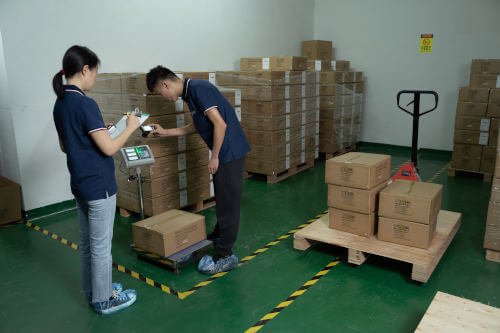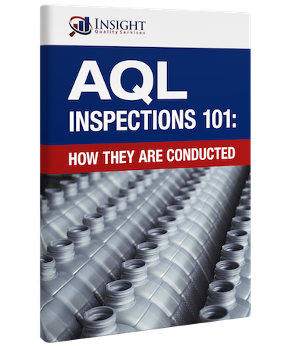When you import goods from overseas, you need them to meet your specifications as accurately as possible. You also need them to meet all health and safety requirements and be acceptable to your customers.
One way to help ensure product quality is to carry out inspections before, during, or after production. And many importers hire specialized third-party inspection companies (like Insight) to conduct these at their factories.
You may be familiar with the AQL sampling standard for product inspections. But have you ever wondered if doing a 100% inspection of your goods might be a better choice? The answer to this question depends on your unique circumstances, as discussed below.
Table of Contents
When Should You Conduct a 100% Inspection?
A 100% inspection refers to inspecting every piece of product in the entire consignment. As you can imagine, checking each component individually is expensive and takes a considerable amount of time.
Even then, some circumstances call for it, such as if you are importing highly specialized goods like medical or aerospace equipment. In other cases, there might be regulatory demands requiring 100% inspections or a discerning customer who demands the same. You may also want to conduct them if you have been having repeated quality problems with your supplier.
However, it is essential to note that 100% inspections are not foolproof, particularly if they are done manually. Because it is a tedious process, mistakes may be overlooked or missed. For the most part, they are more effective when you have purchased a low quantity of goods.
When Should You Conduct an AQL Sampling Inspection?

Insight inspectors checking carton weight during an AQL sampling inspection
AQL stands for ‘Acceptable Quality Limit.’ This international inspection standard defines the ‘quality level that is the worst tolerable’ over the course of many inspections. This sampling method defines how many items are to be inspected in a particular batch size. It also determines how many defective units in a batch will trigger a ‘fail result.’
The inspector takes a sample of the products based on a sampling criterion and looks for defects classified into three types:
- Minor Defects – A product with a minor defect will deviate slightly from the specifications but will likely not impact that product’s usability. For consumer products, the typical acceptable level of minor defects is 4%.
- Major Defects – This type of defect affects the product’s usability and may be rejected by the consumer. The acceptable level of major defects is often set at 2.5%.
- Critical Defects – This is a defect that can potentially harm or injure the user. As such, it renders the product unacceptable and generally has a 0% acceptability level.
If you are importing a large quantity of consumer goods, you will likely use AQL inspections instead of 100% inspections. AQL is a widely accepted inspection method that has been proven to work across different industries.
It is important to note that using AQL does not mean that you will get a defect-free shipment. Instead, it allows you to choose a defect level that you are willing to accept over time. For the most part, this will be dictated by the type of goods you are importing and your customer expectations.
How to Choose the Right AQL and Inspection Levels

Insight product inspector taking photographs during an AQL inspection
If you decide to go with AQL inspection, you will be required to set the levels of acceptable minor, major and critical defects. Several factors will inform this, such as:
The Product
The level of defects you choose to accept will be determined by the specific product you are importing. For instance, if you are importing sensitive goods such as precision equipment to be used in hospitals, aerospace, etc., then you have to maintain a very low defect rate acceptance, in some cases 0%.
Defects in such products can potentially cause harm to human life. Similarly, if you are importing a luxury or expensive product, you may want it near perfect.
Your Customers
If you understand your customers well, then you know the quality of products that they expect. Some customers may be willing to accept slight defects, while others will have higher expectations.
The Market
Another factor that will determine the AQL level you choose is your market. If you are selling your products in the USA or Europe, you will be expected to go with the set international standards.
In addition to the defect criteria, AQL has three general inspection levels, GI, GII, and GIII. These are indicated in the AQL chart, which guides inspections. The higher the inspection level, the larger the sample size. For example, GI represents the smallest sample size, and GIII the largest. It is worth mentioning that GII is the most common inspection level, but this could change based on several factors such as:
Type of Goods
If you are importing low-value goods that are unlikely to cause any harm to users, then you might choose to go with GI, the smallest sample size.
Relationship With the Factory
If your factory has a history of producing high-quality goods that meet your requirements, then you may be comfortable lowering the inspection level. On the other hand, if you are working with a new factory, you may want to increase the sample size as you vet their production quality.
Budget
Larger sample sizes require that you hire more inspectors to do the job or have one inspector spending a few days doing it. You may want to go with the sample size that can be conducted in a single man-day.
Conclusion
Whether you conduct a 100% inspection or use AQL sampling will be determined by the product you are importing, the market, your customers, and your order size. For consumer products, the AQL standard has proven itself to work well over time.
In general, the accepted standards for AQL are GII and 4% for minor defects, 2.5% for major defects, and 0% for critical defects. However, you can adjust these levels to make them more or less stringent, depending on your unique situation.
Next Steps:
- To learn more about adjusting AQL levels, please read our article, How to Choose the Right AQL and Inspection Levels.
- To learn more about our inspection offerings, please see the Product Inspection Services page. If you are thinking about using our services, we can provide additional guidance based on our years of experience.
- To get a complete overview of the AQL sampling method, please download our AQL 101 Guide, seen below.





Writers are a unique breed. You know when you’re reading content written by an expert, or at least a very intelligent writer. After reading this article i get to know more about third party inspection .